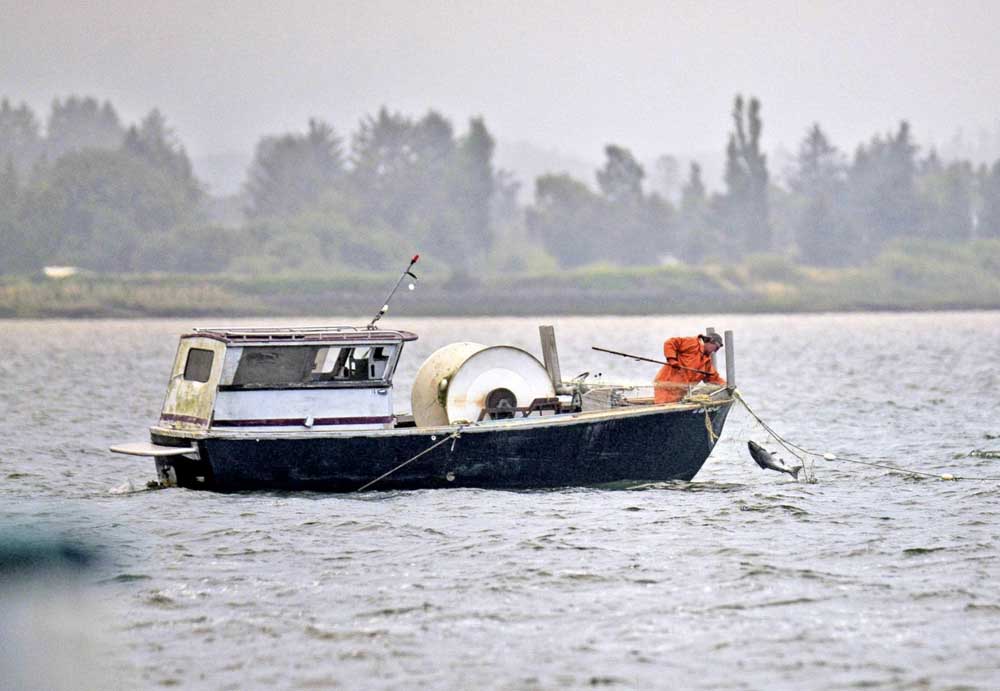Our View: Salmon recovery demands steadfast efforts
Published 6:00 am Friday, March 21, 2025

- A gillnetter works the net-pen fishery in Youngs Bay, part of a long-term effort to ensure some commercial salmon fishing continues on tributaries of the Columbia River.
There is news to cheer and fret about as the 2025 salmon seasons approach.
Deserving at least mild applause, local ocean salmon fishing options just announced by the Pacific Fishery Management Council are somewhat more generous than last year. (Details about proposed alternatives are available on the council’s website at www.pcouncil.org.)
Our Pacific Ocean salmon fisheries north of Cape Falcon — between Manzanita and Cannon Beach — are still limited mainly by the need to avoid harming imperiled Fraser River coho, Washington coastal coho, Lower Columbia River natural coho and lower Columbia River natural tule Chinook. Avoiding damage to these runs means sports fishermen on the ocean will be permitted to keep 46,250 to 59,000 Chinook, compared to a range from 36,000 to 42,500 in 2024. For coho, recreational quotas range from 71,400 to 100,800 marked coho, compared to range from 67,200 to 88,200 marked coho in 2024.
The nontribal ocean commercial fishery north of Cape Falcon includes alternatives that reflect traditional seasons between May and September. Chinook quotas for all areas and times range from 46,250 to 63,500, compared to a range from 36,000 to 42,500 in 2024. Coho quotas range from 13,600 to 19,200 marked coho, compared to a range from 12,800 to 16,800 marked coho 2024.
These quotas would have been laughable a century ago, or even 50 years ago as Columbia and Snake River dams were increasingly choking off major upriver salmon migrations. But numbers like these will sustain important sport fisheries and put salmon on local dinner tables, for which we’re grateful.
Science under threat
The fishery council is part of the National Oceanic and Atmospheric Administration, one of many current targets of helter-skelter firings. Although you won’t have to walk very far along local docks to find vocal critics of NOAA Fisheries — its vessel-based observer program rubs some the wrong way, for example — there also is no doubt its scientific integrity and monitoring of ocean conditions are key to keeping salmon from slipping further toward extinction. If conscientious fisheries experts had been on the job starting a century ago, some awful mistakes could have been avoided.
“It befuddles me to see how unplugging and disassembling rather intricate services that the nation has been provided by this federal agency and others is really making America great again,” a retired NOAA administrator said. “We are going backwards.”
Nor will fisheries and fishermen be helped by hamstringing the National Weather Service — also part of NOAA. Certainly, it is overdue for improvements. Some commercial forecasters and foreign meteorologists like those from the European Centre for Medium-Range Weather Forecasts do excellent work. But it’s difficult to imagine them pouring a lot of up-to-the-minute effort into the weather, winds and waves of relatively unpopulated places like ours.
We ought to be investing more — not less — in understanding the ocean, weather and climate.
Treaties still count
Also on the “worry list” are actions relating to international and tribal treaties. These may barely be a blip on the political consciousness in Washington, D.C., but are enormously important here.
It’s well established that the “treaty tribes” of the Columbia River Inter-Tribal Fish Commission and Northwest Indian Fisheries Commission have legal and moral rights to a share of salmon and other traditionally harvested species. This does not change when the occupant of the White House changes, nor will these guarantees ever go away just because some nontribal fishermen wish they would.
Monkeying around with NOAA Fisheries or anything else that pertains to salmon recovery risks upsetting the delicate balance between tribal, nontribal, commercial and recreational fisheries, plus conservationists and wild salmon advocates. All wish for different outcomes than the established management structure. But willy-nilly cuts to federal agencies will harm all these stakeholders.
Canada treaty stalls
Last but not least, the Trump administration has paused finalizing renewal of the 61-year-old Columbia River Treaty with Canada, an agreement hammered out last July but left unratified. Although it rarely comes up in conversations about U.S. salmon recovery, the river treaty is crucial to management of the vast watershed shared by our nations. In the midst of increasingly tense relations between the two close allies, it’s easy to see how the treaty could become just one more bargaining chip.
An expert on the treaty observed, “The problem with Trump is that he doesn’t seem to care at all about Indigenous peoples and their rights and their interests. He doesn’t care about the environment. He doesn’t care about fish. He hardly even acknowledges the existence of climate change.”
You can find disagreement about all these topics among the large and diverse population of the Pacific Northwest. When it comes to salmon and fish in general, however, the closer you get to the coast and the Columbia River, the more agreement you’ll find. We care about salmon and the healthy habitats they require for success. It’s important to advocate for salmon and for the people who are essential to helping them survive.



